

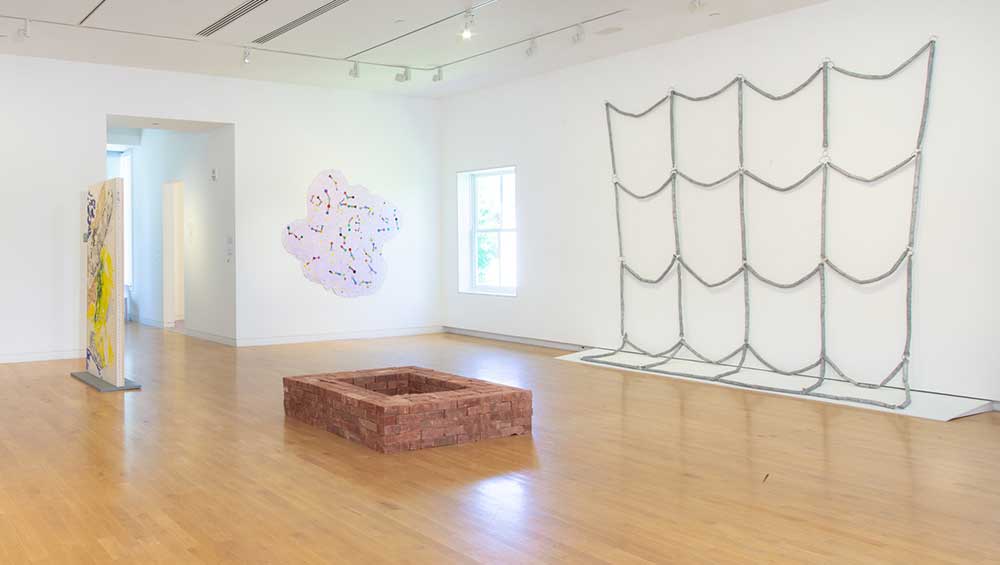
52 Artists: A Feminist Milestone (installation view), The Aldrich Contemporary Art Museum, 6 June 2022 to 8 January 2023. Photo: Jason Mandella.
The Aldrich Contemporary Art Museum, Ridgefield, Connecticut
6 June 2022 – 8 January 2023
by ELIZABETH BUHE
Contemporary feminism advocates for gender fluidity, locates identity somewhere between flesh and data, and seeks to reprogramme systems of race, gender and sexuality. This pluralism and inclusivity are far from the more reductive binary formulation of women v patriarchy that was characteristic of second-wave feminism of the 1960s and 70s. The show 52 Artists: A Feminist Milestone, at the Aldrich Contemporary Art Museum in Ridgefield, Connecticut, seeks to bridge the gap between feminisms then and now by pairing the work of two generations of artists. Its primary object of study is a 1971 exhibition at the same institution called Twenty-Six Contemporary Women Artists, which was curated by the critic-activist Lucy Lippard. The present show revisits the earlier one by presenting artworks by 23 of the 26 original artists alongside the work of 26 artists born in or after 1980. (Of the three missing artists from the 1971 show, Sue Ann Childress and Louise Parks could not be located; Glorianna Davenport declined to participate because her practice has changed significantly.) The younger cohort identify as female or nonbinary, work in New York City, and have not yet had a major museum exhibition in the United States.
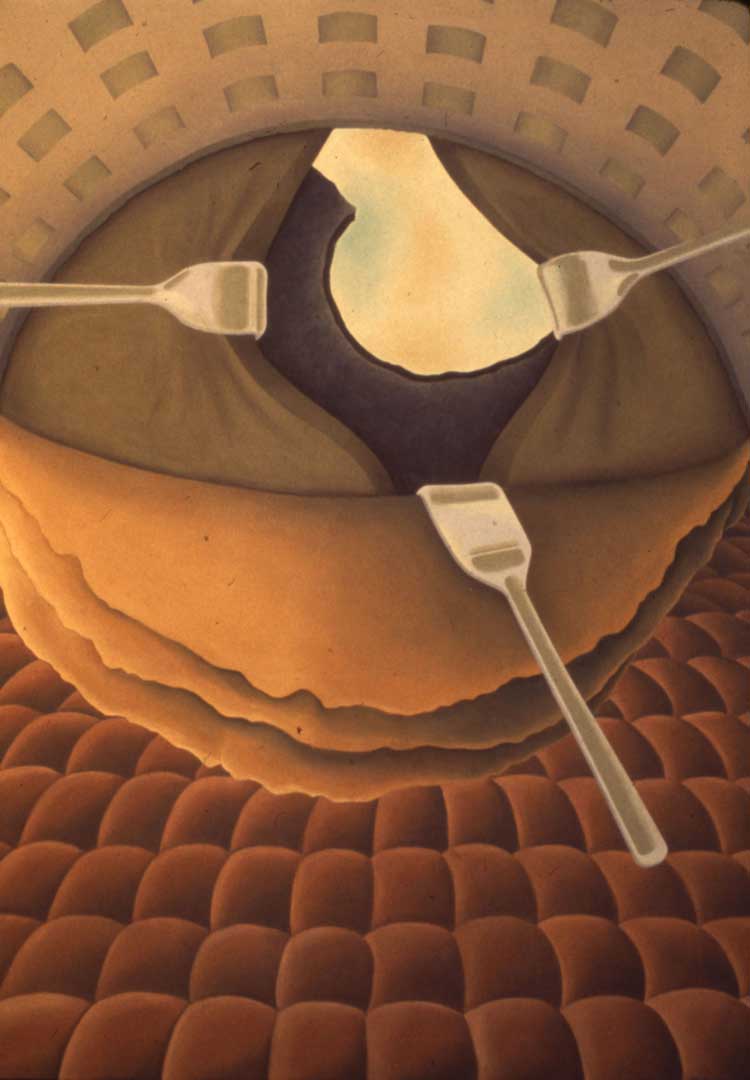
Cynthia Carlson. Untitled Inscape #1, 1970. Oil on canvas, 60 x 42 in. Courtesy of the artist and Richard Saltoun Gallery, London.
The effect is a carefully interwoven tapestry of thematic investigations and medium-specific clusters. Cross-gallery resonances substantiate the exhibition’s comparative logic by elucidating intergenerational throughlines of feminist inquiry, investigated through lenses of changed political contexts. I was struck, for instance, by the treatment of illusionistic space in Cynthia Carlson’s painting Untitled Inscape #1 (1970) and Erin M Riley’s woven wool Webcam 2 (2020). Carlson, later known as a pattern and decoration artist, presents a cloudy sky seen through alternately soft and craggy curtain-like strata pulled back by clawed spatulas. In framing the work by a Pantheon-like coffered ceiling and a red tufted bed, Carlson merges public and private arenas, psychic and lived space, as well as their gendered associations.
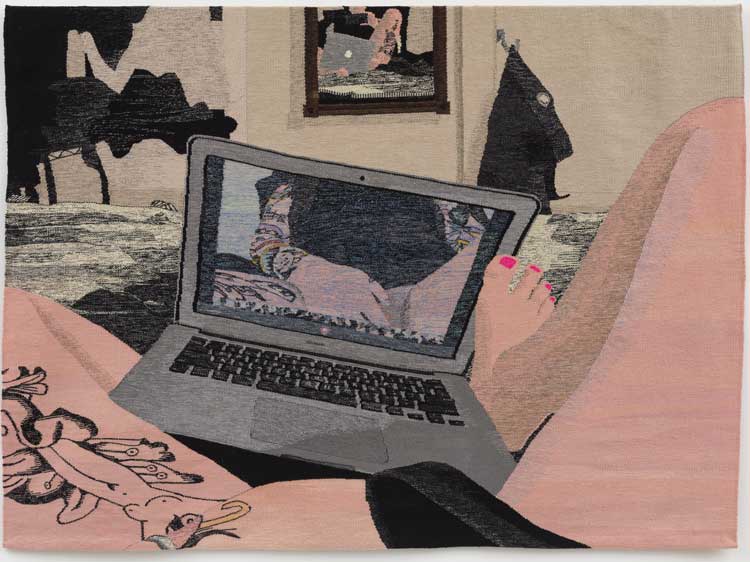
Erin M. Riley. Webcam 2, 2020. Wool, cotton, 72 x 100 in. Courtesy of the artist and P.P.O.W., New York.
Similar concerns play out in Riley’s Webcam 2, a mise-en-abîme of screens framing the artist touching herself in front of her laptop, rendered in perspective low enough to imply that of the artist. As the pandemic entrenched divisions between isolation and sociality, Riley considers “where sexuality would live at a time when physicality was so dangerous”.
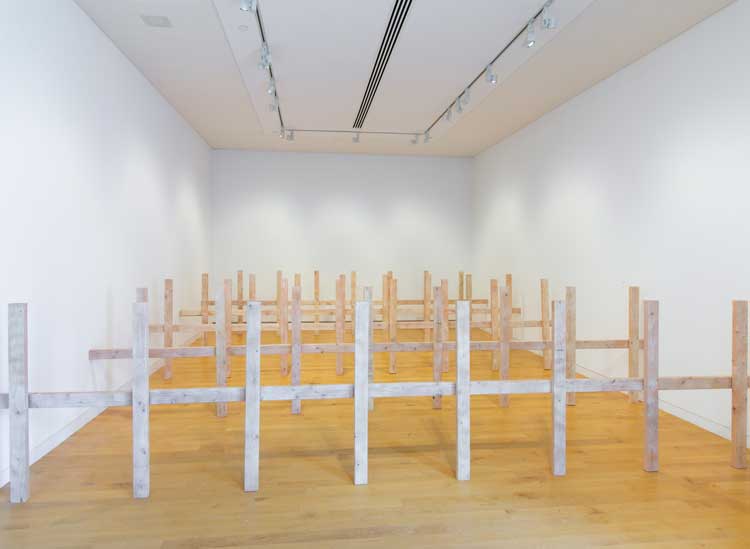
Mary Miss, Room Fence, 1970/2022, Courtesy of the artist, installation view, 52 Artists: A Feminist Milestone, The Aldrich Contemporary Art Museum, 6 June 2022 to 8 January 2023. Photo: Jason Mandella.
Likewise, Mary Miss’s Room Fence (1970) is productively compared with Aya Rodriguez-Izumi’s In the Shadow of Fences I (2022); Miss’s wooden barrier expands to fill the room in which it is shown, thereby delimiting intuitional space, while Rodriguez-Izumi’s chain-link version demarcates the artist’s height, thereby implicating her own body in the history of US military occupation in her birthplace, Okinawa.
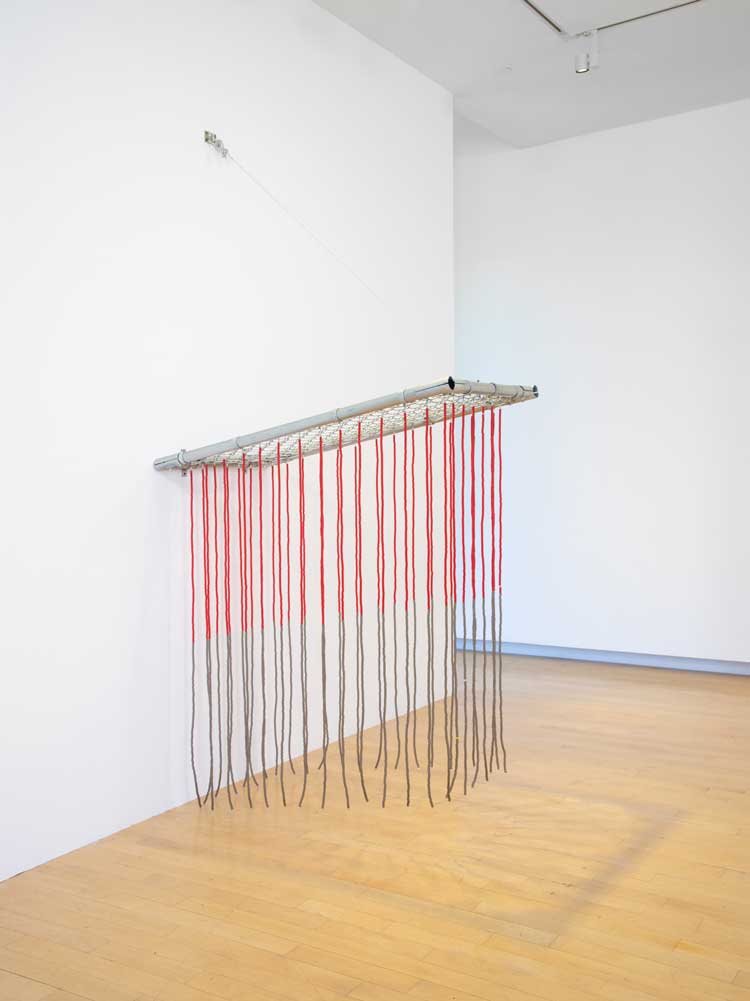
Aya Rodriguez-Izumi, In the Shadow of Fences I, 2022, Courtesy of the artist, installation view, 52 Artists: A Feminist Milestone, The Aldrich Contemporary Art Museum, 6 June 2022 to 8 January 2023. Photo: Jason Mandella.
Gallery-specific themes emerge, though not labelled as such by the curators. The atrium gallery presents a denuded sensuality, as if arguing that the historically coded erotics of female nudes or the “central core” imagery that Judy Chicago once claimed was characteristic of feminist art have been superseded by more nuanced or intersectional motivations. In Elissah’s Hot Pepper Tit (2020), two lumpy breasts hung at human height are adorned by a single black tattoo belonging to Emilie Louise Gossiaux’s sister, whose body Gossiaux records from memory nearly a decade after losing her sight. In other art historical periods, such work may have served to seduce, or to defiantly reclaim, the female form. By contrast, Gossiaux seems to ask what registers of sensory apprehension uphold the forging and recalling of memory, and how these shapeshift over time.
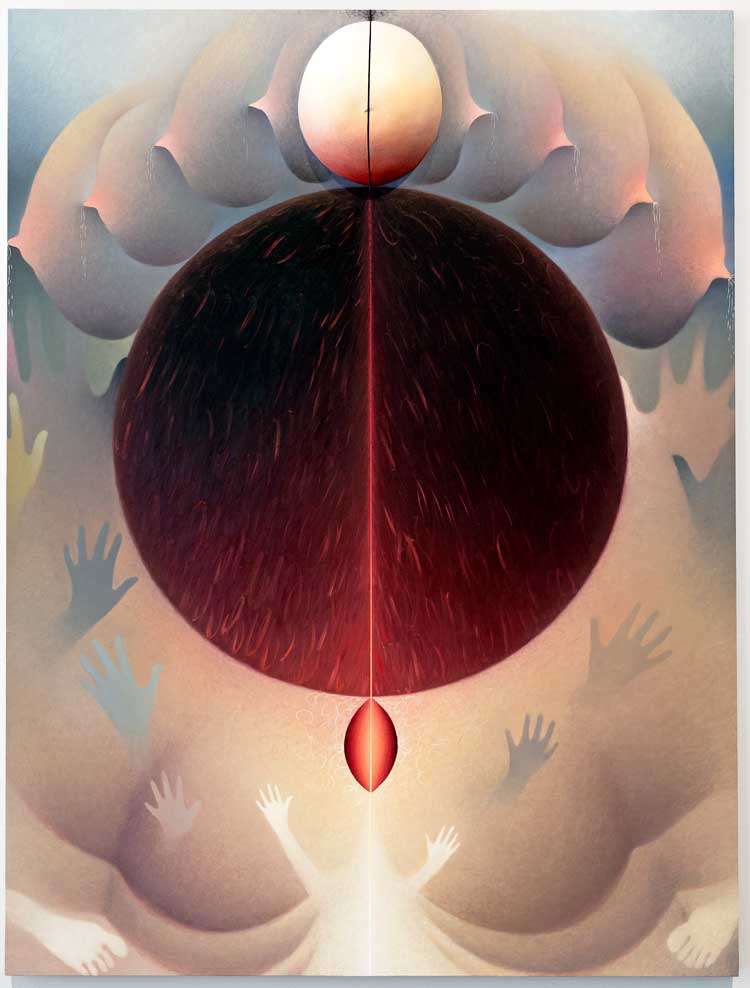
Loie Hollowell. Empty Belly, 2021. Oil, acrylic medium, aqua resin, epoxy resin, on linen over panel, 72 x 54 x 6 in. Courtesy of Loie Hollowell and Pace Gallery. Photo: Christopher E. Manning.
Across the room, in Loie Hollowell’s Empty Belly (2021) a ray of light bisects a magenta orb underneath a protruding cast of a pregnant abdomen. A descending arc of leaking breasts and a crescendo of reaching hands suggest an upward momentum of growth and levitation, on one side, and a contradictory descent into darkness, on the other. Hollowell splinters societal expectations for the (male-gratifying) beatitude of motherhood by conveying her experience of postpartum depression, about which she has spoken openly. Standing at the centre of the atrium as an axis around which the whole exhibition turns, the body of Leilah Babirye’s Ndibasa Namutebi from the Kuchu Mamba (Lungfish) Clan (2022) is totemic, towering, rectilinear, black, and wears braids, but has no clear gender. Thus, the show immediately dispenses with monolithic or objectifying views of feminist art specifically – rejecting, as Lippard wrote in the 1971 catalogue, “the inane cliches of ‘feminine’ art based on superficial characteristics”– and of bodies generally.
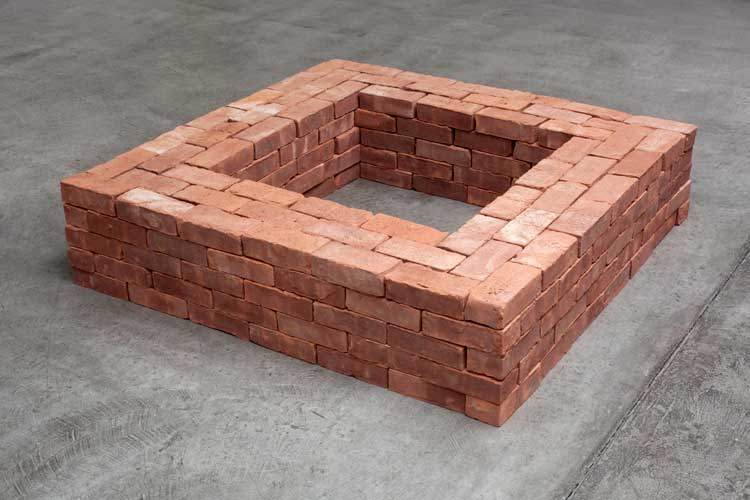
Jackie Winsor. Brick Square, 1971. 300 stacked bricks, 15 x 50 x 50 in. Courtesy of the artist and Paula Cooper Gallery, New York. © Jackie Winsor.
As a second example of gallery thematics, an upstairs grouping upends the patriarchy of the formalist grid through abstraction. Works include Jackie Winsor’s task-based Brick Square (1971), Rachel Eulena Williams’s 2021 painting-collage of circles, rope swoops, and part of a hammock (Pedestal Reeducation), and Carol Kinne’s Cad Yellow (1965), an oil on canvas in the Bennington colour field tradition in which the paint binder of five oblong yellow apertures has leached into unprimed canvas, leaving perceptible halos.
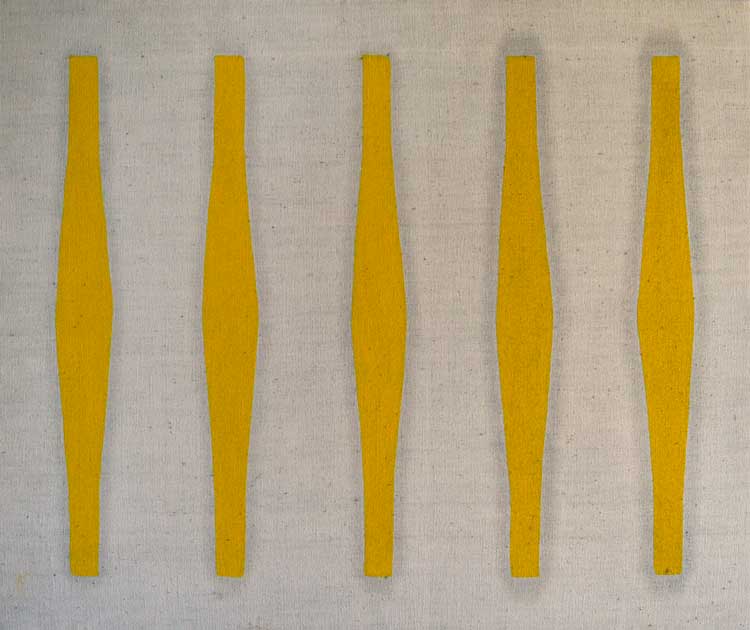
Carol Kinne. Cad Yellow, 1965. Oil on canvas, 22 x 26 in. Collection R. Huot, New Berlin, New York Photo: Edward Hettig.
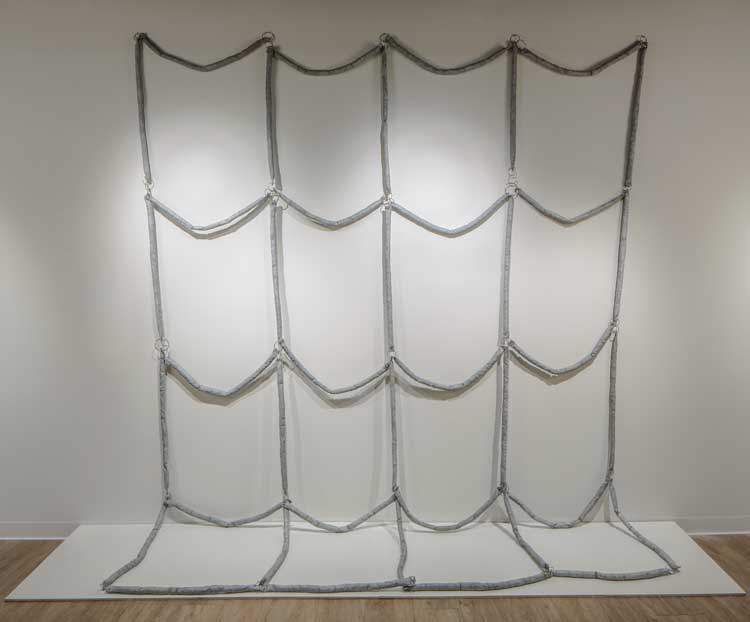
Howardena Pindell. Untitled, 1968–70. Mixed-media assemblage, acrylic paint, canvas, grommets, and stuffing, 144 × 144 in. Mott-Warsh Collection, Flint, Michigan. Photo: Robert Hensleigh and Tim Thayer.
A standout work is Howardena Pindell’s Untitled (1968-70), a floor-to-ceiling soft grid held together with looseleaf clips. Fabricated from canvas tubes stuffed with foam, the grid’s ligaments cohere limply, suggesting the work’s entropic potential to collapse into an indiscriminate pile, or to be packed up and carried. In this gallery, artists unseat the male codes and geometries of aesthetic tradition by mobilising to different ends the shapes or discourses of formalism and the capacities of their materials: how gravity effects an unseen body in repose, how paint drips, how bricks might be stacked. Within the last decade, art historical scholarship has emphasised that artists who are not white men should not be expected to disclose their subject position – often through figuration – in order for their work to earn historical import. Comparably, most of these abstractions are not overtly “feminist” (an evaluation nonetheless dependent on a viewer’s familiarity with discourses of minimalism, process and land art, in these cases), nor need they be to work powerfully here.
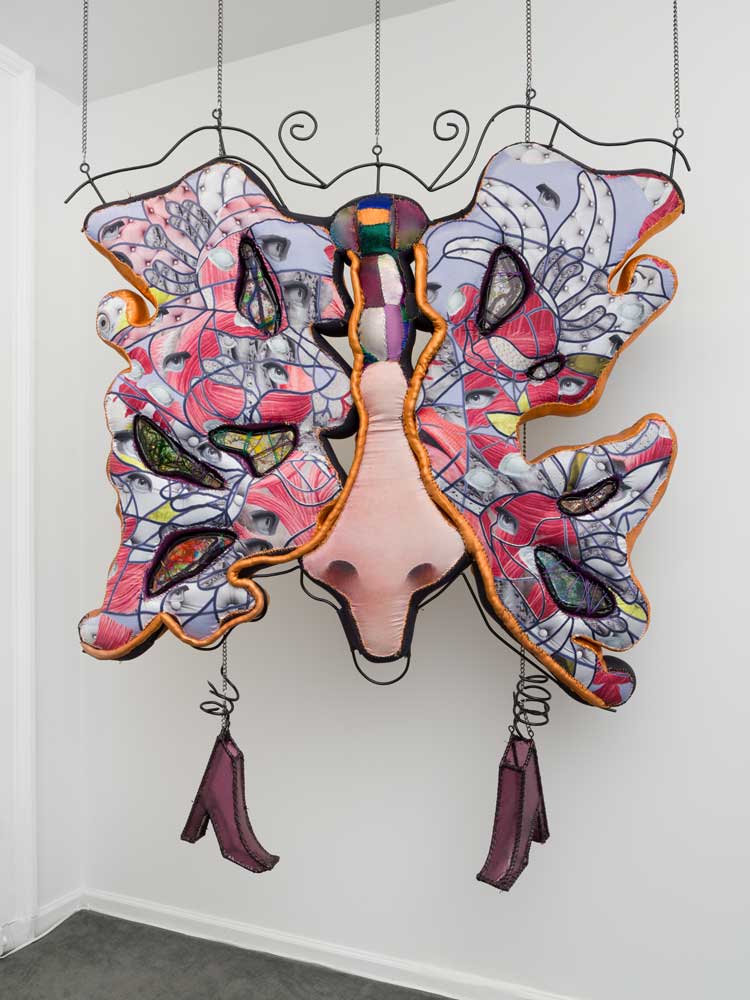
Florencia Escudero. Talisman, 2021. Hand-sewn digitally printed satin, spandex, and hand-marbled digitally printed fabric, hand-sewn spandex over cotton piping, foam, resin cast with metal earrings, rings, fake pearls, charms, ceramic beads, confetti, plastic crystals, false dread locks and braids, wrapped in wires and hand-sewn vinyl over piping, with hand-sewn crocodile-stamped vinyl, metal, and handbag chains, 87 x 54 x 7 in. Collection of Selig D. Sacks. Photo: Charles Benton. Photo courtesy of the artist and Kristen Lorello, New York.
One could easily continue in this vein, chronicling conceptual crossovers and historical reverberations throughout the show. But it is perhaps more useful to enumerate thematic strands that stood out to me in addition to the two suggested above, equally applicable to both generations: the surfacing of collective history to inform present formulations of identity, individual and structural; building chosen communities; dissent toward parental expectation and institutional power; and the site-specificity of earth. Given the exhibition’s premise of showcasing emerging artists alongside their feminist forebears, it is surprising that only two artists openly acknowledge feminism’s intergenerational labour by citing their predecessors. Aliza Shvarts is one; in Homage: Congratulations (2017), an index-sized RSVP card informs its recipient of the power imbalances that uphold the institution of marriage. Intended to be mailed by museum visitors as a means of declining a wedding invitation, the work pays tribute to Adrian Piper’s My Calling (Card) (1986-90), distributed by Piper at social gatherings to call out anti-black racism. Piper featured in Lippard’s 1971 exhibition and presents a recent photographic series in 52 Artists; her Whistleblower Catalysis was also restaged at the opening, during which performers blew silver whistles for several seconds at a time throughout the duration of the opening. Like Shvarts, Barbara Zucker honours feminist luminaries – her friends Lippard and the prolific art historian Linda Nochlin – in a new installation that plays audio recordings of both writers reading seminal texts from the period, surrounded by sculptures of iridescent Plexiglass that are abstracted, enlarged and sourced from Nochlin’s and Lippard’s wrinkles as captured in photographs.
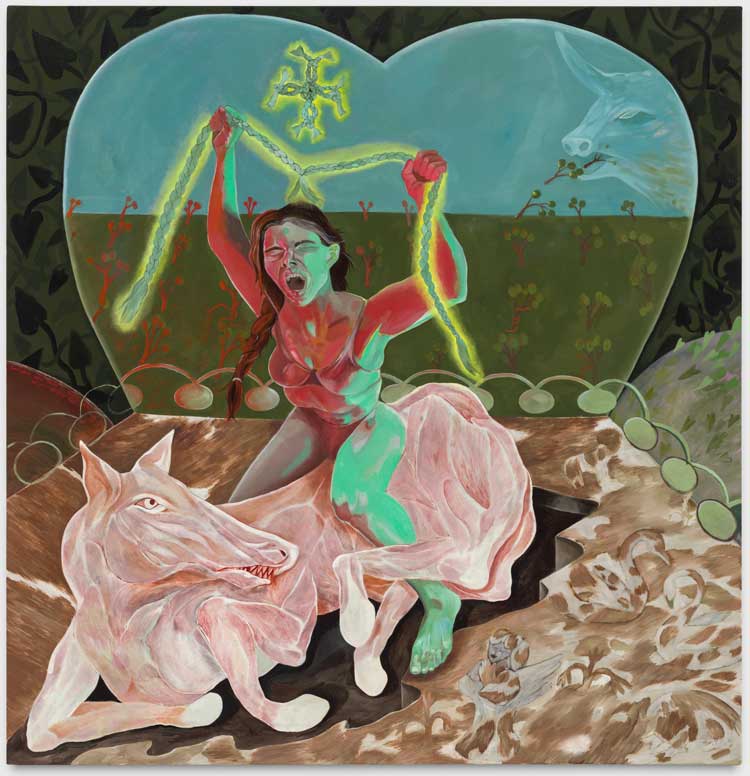
Astrid Terrazas. someone will make a Saddle out of your falling hair, 2021. Oil, cochineal pigment on canvas, 60 x 60 in. Courtesy of the artist and P.P.O.W., New York. Photo: Stan Narten.
52 Artists is a laudable exhibition with threefold significance. It insists on the consequence of Lippard’s curatorial work writ large, it re-emphasises the work of the artists Lippard selected as advancing feminist labour then and now, and it nominates an emerging cohort whose output is extremely strong and engages contemporary feminism in some way. (Underscoring the last point, I could extol the virtues of nearly every artwork in the show; of those artists not yet discussed, Cecile Abish, Alice Aycock, Lizania Cruz, Florencia Escudero and Astrid Terrazas deserve mention.)
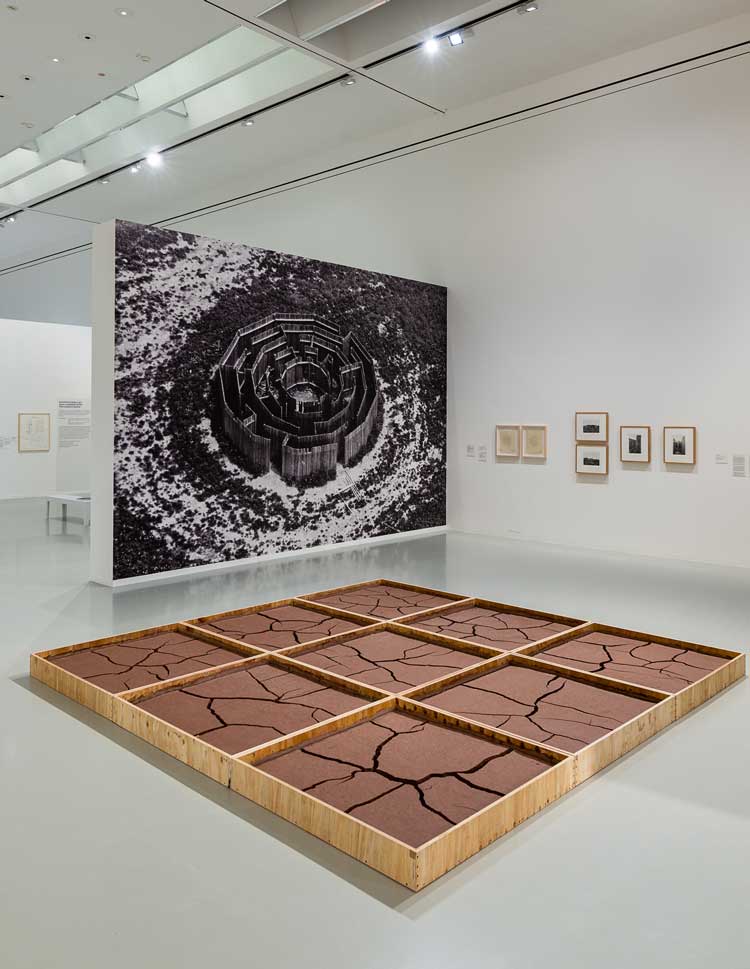
Alice Aycock. Clay #2, 1971. Clay mixed with water in wood frame, 48 x 48 x 6 in each. Courtesy of the artist. Collection 49 Nord 6 est - Frac Lorraine, Metz, France. Photo: Herling / Herling / Werner, Installation at the Sprengel Museum, Hannover, Germany, 2019.
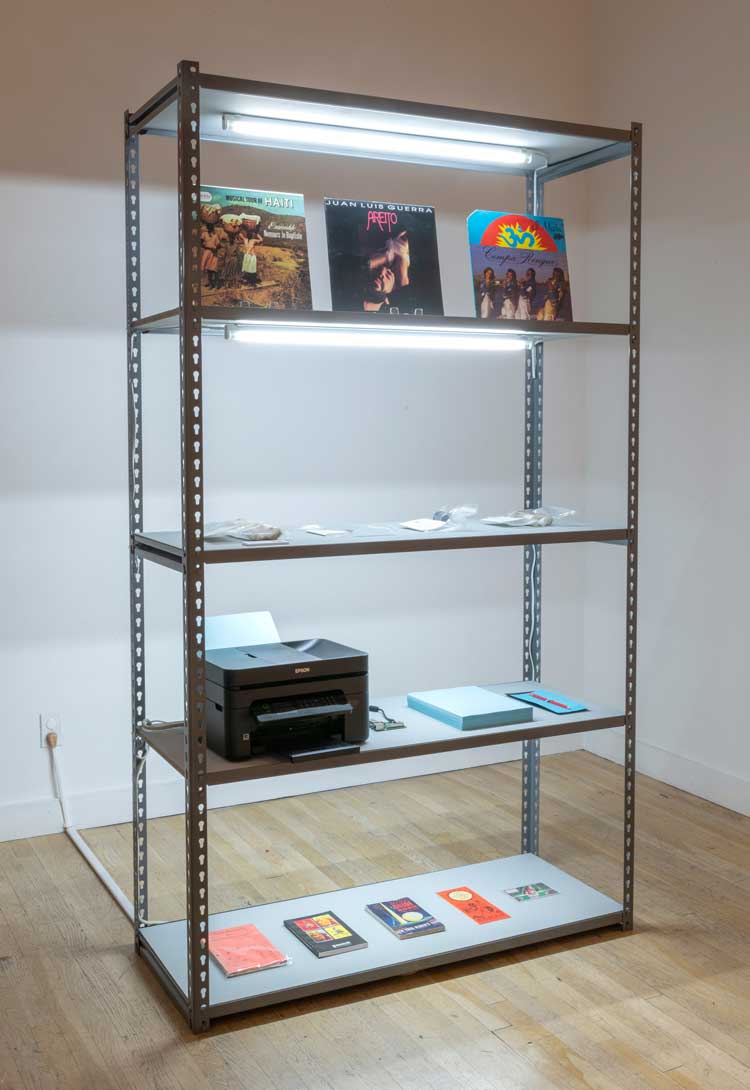
Lizania Cruz. Evidence Shelf, Investigation of Dominican Racial Imaginary, 2022. 48 x 18 x 8 in. Courtesy of the artist. Photo: Adam Reich.
Yet these three achievements leave open a two-part question: how to justify the representation of an altered version of Lippard’s show, and this alongside the juxtaposition with new artwork? Certainly, restaging a historic exhibition is challenging under the best of circumstances. Alexandra Schwartz, one of the show’s two curators, led the art historical research admirably. As she explained in a public talk, apart from contemporaneous press (often misogynistic) and some installation photographs discovered midway through their curatorial work, little information remains about Twenty-Six Contemporary Women Artists, which was staged in the Aldrich’s former exhibition space, now staff offices. The list of works in the catalogue turned out not to be an accurate checklist. Not all the artworks in the photographs could be identified. Many were made with polyurethane foam, then a new and attractive material, but one that has held up poorly over time. As a result, only eight of the pieces originally shown in Lippard’s show are exhibited here.
Aldrich senior curator Amy Smith-Stewart, who selected the 26 younger artists, has said that 52 Artists updates the parameters of Lippard’s show to encompass today’s international, intersectional, gender-fluid feminism. Less clear is the show’s ontology – is it a re-enactment, a restaging, a sequel, a tribute (with additions)? Perhaps the catalogue, not yet published, will answer this question. For now, though, these terms matter, impacting the institutional framework in which the work is shown, and the expectations viewers bring to it. The 2013 restaging in Venice of Harald Szeemann’s 1969-70 exhibition in Bern, Live in Your Head. When Attitudes Become Form: Works – Concepts – Processes – Situations – Information, offers a germane precedent. Despite the obvious differences in curatorial approach, most notably that When Attitudes Become Form did not add new artists to the original roster and pursued historical accuracy through indicating missing artworks with dotted lines on floors and walls, its accompanying texts critically examined – if left unresolved – lexicons of reactivation and restaging and their theoretical implications. In the realm of conservation, scholars have trodden similar territory for art roughly contemporaneous to Lippard’s show. I am thinking of Object Lessons: Case Studies in Minimal Art: the Guggenheim Panza Collection Initiative (2021), a book-length study examining the impact of artworks’ fabrication and display histories on their materiality, institutional treatment and ontological status.
Grappling directly with these issues in didactic materials would better inform 52 Artists’ viewers what, exactly, they are encountering. As far as I could tell, the only way to discern if an artwork was included in the original 1971 exhibition was to read every wall label. The cumulative lack of clarity engendered by all this is accentuated by contrast to Lippard’s frankness in detailing her own curatorial process and emerging feminist methodology in her exhibition catalogue 51 years ago. As she wrote then, she “took on this show as a form of personal retribution to women artists I’d slighted, unintentionally, in the past” due to sexist “common conditioning from which we all suffer”.
The artists, of course, have exemplified the feminist stance of structural change through their work all along. Dona Nelson, who presents 1968 and 2019 canvases of splashed paint and aleatory gesture, relates the instability of painting as a form to individual identity. She remarked: “I’ve never been comfortable with traditional pronouns, and I’m not comfortable with the new pronouns either. I am comfortable being called a painter, because paintings exist on unstable ground, and that seems to me to be what life is.” This sentiment is echoed in work by the younger generation, who should have the last word. Amaryllis DeJesus Moleski fabricated the sculptural component of The Girl Has Teeth and the Teeth are Tired (2022), a transformer-like ceramic girl with human hair and accompanying video, using the pottery technique of nerikomi. As Moleski explained, nerikomi entails “cutting and reattaching different clay bodies together to create a pattern through meticulous destruction and re-formation, so it’s not a surface treatment but it’s structural … the pattern exists through the whole body.”